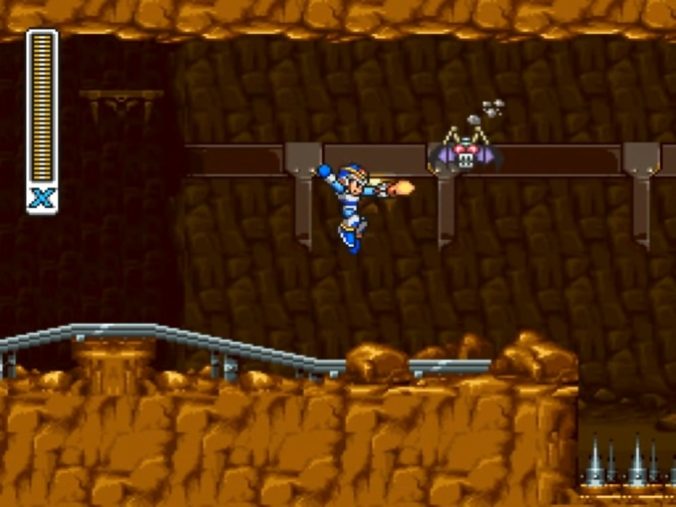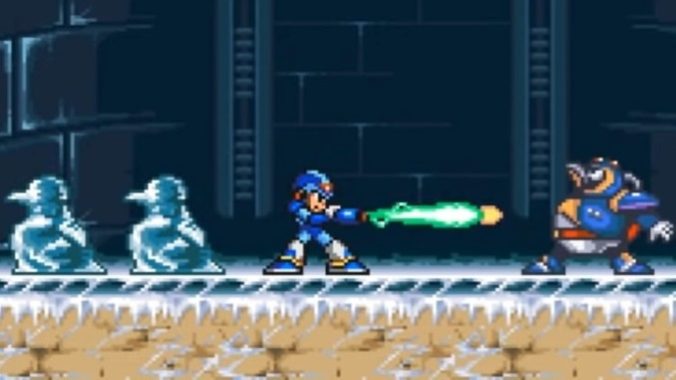Maybe it’s a little tough to believe if you weren’t there for it, but there was once a time when there were arguably too many Mega Man games releasing at once. Whereas in more modern times, Mega Man 9, Mega Man 10, and Mega Man 11 were released over the course of an entire decade, it didn’t used to be like that. Mega Man was one of Capcom’s most successful home franchises in the late ‘80s and ‘90s, and they beat it into the ground basically from the moment that success began.
In 1993, the same year Mega Man X originally released in Japan, Mega Man 6 for the NES and Mega Man IV for the Game Boy were also released. Consider: Mega Man had debuted in both Japan and North America in December of 1987, while Mega Man 3 didn’t even come out until 1990, and yet, by 1993, the NES series was on its sixth entry, and the spinoff portable series was on its fourth. And those Game Boy games were very much just rehashes of the NES games that had come before, using a mix of robot masters from those titles but in a new—but not that new—context. While games like Mega Man 5 and Mega Man 6, the last two NES entries, weren’t bad by any means, they were also struggling to be anywhere near as interesting and innovative as earlier titles, like the game-changing Mega Man 2.
Capcom had multiple teams cranking out Mega Man games to try to get something going. There was the core Capcom team working on the first six NES titles, then Minakuchi Engineering on all but the second of the Game Boy ones, which was handled by Thinking Rabbit. Mega Man: Dr. Wily’s Revenge and its sequel, Mega Man II, released five months apart in 1991 for the same platform, which is why Capcom had briefly switched developers. The intense, shortened development cycle of II led to a subpar game, the soundtrack of which suffered due to what was either a programming error or a tonal overcorrection—either way, there was no time to fix it before shipping the game out.
The point is that Capcom needed to let off the gas a little and truly change things up if they were going to be able to make Mega Man as enjoyable as it was back when Mega Man 2 reached what ended up being, for quite some time, the high point of that core series. Mega Man X ended up being that opportunity.
No more humanoid robot masters, as the series would shift to animal inspiration, vastly changing the design opportunities of the major foes while doing away with the [Power] Man naming convention, too. All I’m saying is that the previous Mega Man games weren’t going to make room for “Boomer Kuwanger,” but Mega Man X could. No more Dr. Wily, as he would be replaced as antagonist by a genocidal robot—or reploid, in Mega Man X parlance—known as Sigma. The game would be set in a different time period, and would revolve around Dr. Light’s final creation: X, a robot with the capacity for war, yes, but who was designed to be able to live out a life of peace, if only the world would grant him the opportunity. When Sigma decided that the problem with the world was all of the humans in it, well, X’s potential life of peace had to be put on the back burner, since his options were to either join Sigma in ridding the planet of its non-reploid citizenry along with the other Mavericks, or fight back.
A fresh setting meant more than just new robot designs and a new antagonist, though. It also meant that X didn’t have to be the strongest robot around, either: that designation, at the game’s start, went to Zero, who was an experienced Maverick Hunter whom X could look up to. You spend Mega Man X building up both X’s confidence in his abilities and his actual abilities, until he’s ready to have the proverbial torch passed to him. The stories of Mega Man games could sometimes be a little nonsensical—or, at least, their localizations made them that way—but the first X kept it simple and human in a way that allowed for actual emotional and narrative beats.

This also worked itself into the gameplay, as Mega Man X is intentionally designed to be quite different from the Mega Man of the past. He looks an awful lot like the all-blue Mega Man people were familiar with—at least, a 16-bit edition of that character—but then you start to grab the armor upgrades that Dr. Light left behind along with messages from the past, and his look changes. X’s armor ends up far whiter, more angular, sharper in both appearance and in the sense that it looks pointier, too. And each armor piece opens the game up in different ways: a dash that allows for speedier runs or further jumps, a helmet for breaking open certain blocks and ceilings, armor to cut your damage in half, and a second style of charging arm buster that lets you not only fire off a much larger and more powerful attack, but also gives every collected robot master’s ability a secondary fire. And they range from firing off a round of giant boomerangs instead of a single one, to creating a sled you can ride made out of ice, to straight-up temporary invincibility to help you get through tough platforming sections… which is of course attached to one of the most useful and oft-used abilities you’ll have in the game, so you can’t abuse either of its functions without suffering in the other area.
It’s not just X that changes throughout the game. The way the whole world interacts with itself is fascinating, and the absence of this in later X entries is a mark against them, and a part of why their level design is inferior to the original’s. Traditionally, in a Mega Man title, you figure out which robot master is going to be the easiest to defeat with your base buster cannon. Then you take whatever ability they give you, and go off to fight the robot master who is weak to that new ability, and so on, until you’ve defeated them all and opened up the path to Dr. Wily’s latest hideout.
In Mega Man X, however, you don’t just consider, say, that having Flame Mammoth’s Fire Wave would make defeating the Chill Penguin easier. You have to also think of the fact that defeating the Chill Penguin stage first will ice over Flame Mammoth’s factory, meaning you no longer have to avoid lava there and can access some otherwise inaccessible upgrades. Spark Mandrill’s whole stage is often either electrified in a way that can harm you or powering up some enemies who can fire electricity at you, but if you defeat Storm Eagle his airship then crashes into Mandrill’s level, causing a power outage that wipes all of that danger out. It’s a bit of give and take, since you need to figure out which stages you prefer to have nerfed a bit vs. which bosses you might defeat without their weakness equipped, but it creates a depth and freedom of choice in how the game will play out that makes Mega Man X remain both fresh and special even if you’ve played it dozens of times.
Hell, even though I’m one of the people I’m referring to there, with countless playthroughs of the classic in its 30 years, it’s only somewhat recently, while playing through its most recent release as part of 2018’s Mega Man X Legacy Collection, that I learned that you could cut off Flame Mammoth’s trunk using Boomerang Cutter. This keeps him from using either his Fire Wave or from shooting out the oil he’d set aflame with said fire, and it’s not like he’s weak to Boomerang Cutter in terms of the health bar damage it does. You discover this by seeing what happens, or in a moment of desperation, or because you read about it on the internet. There are just so many little things like this to discover that change the game and how a run will play out, if you bother to experiment and find them, and they go well beyond just that basic rock-beats-scissors recognition needed in past games (as well as plenty of future ones, too).
My four-year-old watched my most recent play of Mega Man X, which I didn’t need to get to before writing this, such is my history with the game, but here’s the thing: It’s still one of the best Mega Man-related ways you can spend a couple of hours all this time later, so I did. No exaggeration, but every time I’d begin a new level, my kid would say some form of, “Wow this song is great, too.” And he was right to think so! Mega Man X’s soundtrack is banger after banger, with Capcom taking full advantage of the jump from the NES’ audio hardware to that of the SNES. Some developers didn’t quite nail the SNES sound, sure, but Mega Man X came out in December of 1993 in Japan, January of 1994 in North America: Capcom had years’ experience with the hardware by this time, and it showed in this selection of high-quality, catchy hard rock. Picking a definitive crowd favorite track is near impossible: ask around, and you’ll get a slew of different answers. Storm Eagle’s stage might get the most votes if you actually did this, but Spark Mandrill’s theme, that of the opening stage, Zero’s theme, Armored Armadillo, or literally anything from Sigma’s fortress would garner plenty of votes, too. And the first Sigma battle theme is one of the hardest tracks on the SNES, with Capcom deciding that speed metal was the only way to score a fight against a robotic acrobat equipped with what looks an awful lot like a lightsaber. What a soundtrack.
Mega Man X is a fantastic entry point for the series as a whole, equipped with a killer soundtrack, superior level design to what had been showing up in the core Mega Man games at that point, as well as better than much of what would come later in the X series, too. Everything about it is both streamlined to hook you rather than intimidate you, and loaded with depth that would prove difficult to replicate. The one criticism you could lob against it is a fair one: it’s not as tough as plenty of other Mega Man titles, including future X games. It barely matters, though. Everything else is so on point, and the aforementioned depth and the secrets worth mining give you a different kind of challenge. One worth meeting either for the umpteenth time or the first, in a way fewer Mega Man titles than you’d think are.
Marc Normandin covers retro videogames at Retro XP, which you can read for free but support through his Patreon, and can be found on Twitter at @Marc_Normandin.

